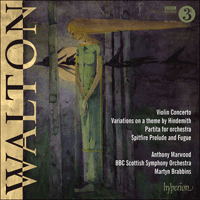Written by Jeff Counts

Instrumentation: 2 flutes (2nddoubles piccolo), 2 oboes (2nd doubles English horn), 2 clarinets, 2 bassoons, 4 horns, 2 trumpets, 3 trombones, timpani, tambourine, cymbals, field drum, xylophone, harp, strings
Concerto for Violin and Orchestra of Sir William Walton, discussing more specifically the shape of the Concerto for Violin in England between 1900 and 1940, taking in consideration the works of Charles Villiers Stanford, Edward Elgar, Samuel Coleridge-Taylor, Frederick Delius, Ralph. Register now to continue reading Thank you for visiting Gramophone and making use of our archive of more than 50,000 expert reviews, features, awards and blog articles. The orchestral overture Portsmouth Point (which he dedicated to Sassoon) was the first work which shows Walton’s real style. In 1929 the Viola Concerto started to make him really famous. This was followed by Belshazzar's Feast, the Symphony No. 1 (1935), the coronation march Crown Imperial, and the Violin Concerto. All these works are very. The orchestral overture Portsmouth Point (which he dedicated to Sassoon) was the first work which shows Walton’s real style. In 1929 the Viola Concerto started to make him really famous. This was followed by Belshazzar's Feast, the Symphony No. 1 (1935), the coronation march Crown Imperial, and the Violin Concerto. All these works are very. Category:Walton, William/Collections (The following text was automatically transcluded from Category:Walton, William.) All works by this person are still under copyright in Canada, the EU, Japan, and elsewhere and are thus subject to deletion.
Duration: 31 minutes in three movements.
THE MUSIC – Writing a concerto for someone with the stature of Heifetz was daunting for Walton. He worried that he would not make the solo part difficult enough or spectacular enough, leaving the piece unworthy of Heifetz and his legend. According to his wife, Walton actually considered giving the piece to another violinist so as not to offend the commissioner but eventually convinced himself that he had “exhausted the possibilities of what one could do on a violin,” which meant he could show it to Heifetz without fear. The two met in America in 1939 and worked out the finishing touches together, making adjustments to the third movement in particular. It was an intense period for Walton, prompting him to quip, “I seriously advise all sensitive composers to die at the age of 37.” The premiere did not happen in New York after all and when it did finally take place in Cleveland later that year, Walton was needed at home in wartime London and could not be present. In another fateful twist of the war, the valuable U.S. performance materials were lost during their crossing of the battle-torn Atlantic but Walton, undaunted, conducted the British premiere anyway in 1941 with Henry Holst as soloist. The Concerto underwent some revision in 1943 and now survives as one of Heifetz’s most memorable commissions, a crafty tour de force that Lady Walton said her husband often humbly (and paradoxically) referred to as “rather intimate.”
THE WORLD – Notable literary publications in 1939 included Finnegans Wake by James Joyce, The Day of the Locust by Nathaniel West and Johnny Got His Gun by Dalton Trumbo. Also in that year, Al Capone was released from Alcatraz and LaGuardia airport was officially dedicated.
Violin Concertos Listen
Brahms 1 & Prokofiev
Utah Symphony’s Patriotic Pops featuring Capathia Jenkins
Kool & the Gang with the Utah Symphony
Kristin Chenoweth with the Utah Symphony
Walton Violin Concerto Pdf Writer Download
Super Diamond with the Utah Symphony
The Temptations with the Utah Symphony
The Magical Music of Harry Potter
Take Me Home: The Music of John Denver starring Jim Curry with the Utah Symphony
Little River Band with the Utah Symphony




